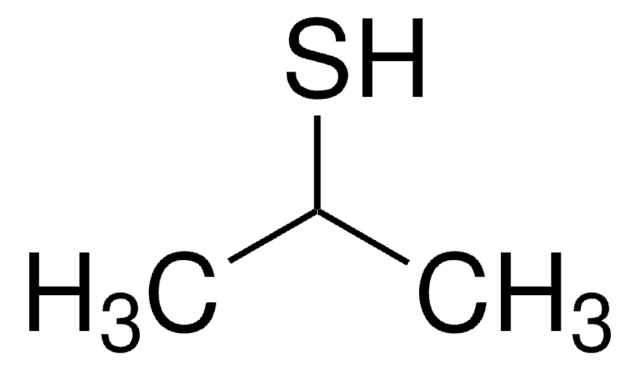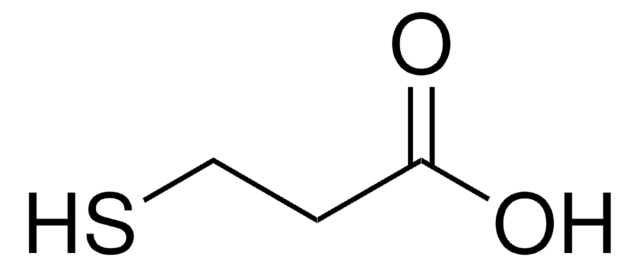115924
3-Methyl-1-butanethiol
97%
Synonym(s):
Isoamyl mercaptan
Sign Into View Organizational & Contract Pricing
All Photos(1)
About This Item
Linear Formula:
(CH3)2CHCH2CH2SH
CAS Number:
Molecular Weight:
104.21
EC Number:
MDL number:
UNSPSC Code:
12352100
PubChem Substance ID:
NACRES:
NA.22
Recommended Products
vapor pressure
41.4 mmHg ( 37.7 °C)
Assay
97%
refractive index
n20/D 1.4432 (lit.)
bp
117-118 °C (lit.)
density
0.835 g/mL at 25 °C (lit.)
functional group
thiol
SMILES string
CC(C)CCS
InChI
1S/C5H12S/c1-5(2)3-4-6/h5-6H,3-4H2,1-2H3
InChI key
GIJGXNFNUUFEGH-UHFFFAOYSA-N
Looking for similar products? Visit Product Comparison Guide
General description
3-Methyl-1-butanethiol is one of the volatile components obtained by the GC-MS analysis of the anal sac secretion from the spotted skunk, Spilogale putorius.
Application
3-Methyl-1-butanethiol has been used as an organic clapping layer in the synthesis of monolayer-capped 5 nm gold nanoparticles.
Signal Word
Danger
Hazard Statements
Precautionary Statements
Hazard Classifications
Eye Irrit. 2 - Flam. Liq. 2 - Skin Irrit. 2 - STOT SE 3
Target Organs
Respiratory system
Storage Class Code
3 - Flammable liquids
WGK
WGK 3
Flash Point(F)
64.4 °F - closed cup
Flash Point(C)
18 °C - closed cup
Personal Protective Equipment
dust mask type N95 (US), Eyeshields, Gloves
Choose from one of the most recent versions:
Already Own This Product?
Find documentation for the products that you have recently purchased in the Document Library.
Customers Also Viewed
W F Wood et al.
Journal of chemical ecology, 17(7), 1415-1420 (1991-07-01)
GC-MS analysis of the anal sac secretion from the spotted skunk,Spilogale putorius, showed three major volatile components: (E)-2-butene-1-thiol, 3-methyl-1-butanethiol, and 2-phenylethanethiol. Minor volatile components identified from this secretion were: phenylmethanethiol, 2-methylquinoline, 2-quinolinemethanethiol, bis[(E)-2-butenyl] disulfide, (E)-2-butenyl 3-methylbufyl disulfide, bis(3-methylbutyl) disulfide. All
G Peng et al.
British journal of cancer, 103(4), 542-551 (2010-07-22)
Tumour growth is accompanied by gene and/or protein changes that may lead to peroxidation of the cell membrane species and, hence, to the emission of volatile organic compounds (VOCs). In this study, we investigated the ability of a nanosensor array
Our team of scientists has experience in all areas of research including Life Science, Material Science, Chemical Synthesis, Chromatography, Analytical and many others.
Contact Technical Service


